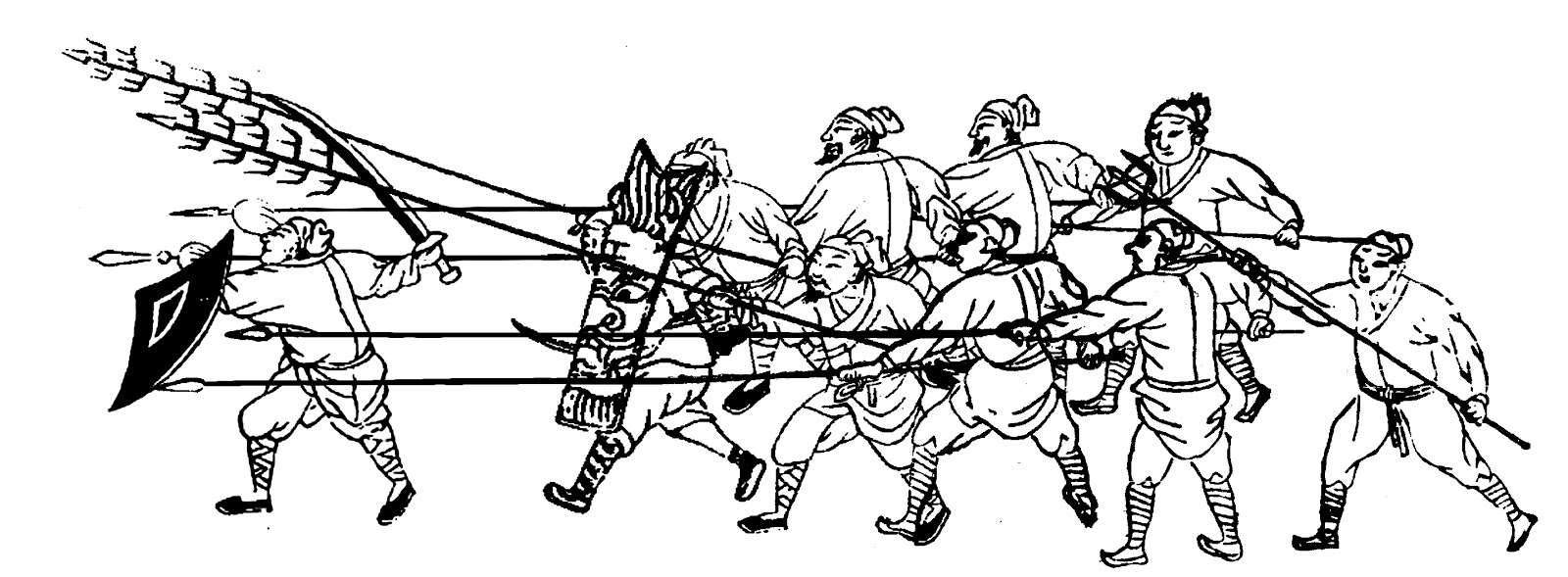What's your opinion about this Chinese ancient weapon and battle strategy?























Steve James wrote:I think that the weapon's usefulness will depend on the use to which it's put. We could ask whether the weapon and the formation are meant for attack or defense. General Qi had a specific problem to address. Iinm, he became well known because of his success against pirates. I've heard that the miao dao was developed to counter the Japanese long swords. But, the diagram suggests that it was more of a distracting/delaying tool rather than an offensive weapon. The video shows that the weapon was relatively light and flexible. I could see that lots of them could cause problems to attackers, but they'd have to be well backed up. I'm also interested to see what and how much training that the average person of that time would need to use the weapon the way it was expected.
Source
Lang Xian (狼筅, can be written as 筤筅, lit. 'Wolf brush'), sometimes translated as "wolf bamboo" and "multiple tipped bamboo spear", is arguably the MOST uniquely Chinese weapon ever devised. It is essentially an extremely long bamboo shaft mounted with an iron spike, with branches and leaves still attached. The branches are sometimes fire hardened or attached with blades and hooks and smeared with poison.
The use of Lang Xian was first recorded during a miner's revolt, headed by Ye Zong Liu (葉宗留), around 1444 AD. It was later adopted by Ming army.
The famous Yuan Yang Zhen (鴛鴦陣), known to the West as Mandarin Duck Formation, was devised by Ming general Qi Ji Guang (戚繼光) during his campaign against Wokou (倭寇, Japanese coastal pirates). With this formation, Qi Ji Guang never tasted a single defeat in his campaign against Wokou, often completely annihilating his enemy with little to no casualties.
the Mandarin Duck Formation was very simple and straightforward and did not require a high level of martial art skills nor complex maneuvers to be effective (Qi's army was comprised of peasants and miners, most of whom were illiterate). While Mandarin Duck Formation was designed for small engagements, it could be used in large scale battles numbering thousands of troops as well.
When facing the enemy, both swordsmen crouched at the front rank to protect all those behind them with their shields. Once the battle was joined, the swordsman with rattan shield would throw his javelin and made a quick dash to charge at the enemy, while the swordsman with Ai Pai (挨牌) stood his ground. Lang Xian were projected over the head of swordsman to provide cover, and pikemen guarded the left and right flanks of the Lang Xian. If enemy somehow managed to get pass the Lang Xian and pikemen, they had to face the shorter but no less deadly Tang Ba.
Comparison with European pike formations
With the exception of Lang Xian, Qi Ji Guang's tactic seems to draw parallels with the opinions of sixteenth century European military writers such as Sir John Smythe, Matthew Sutcliffe, Niccolò Machiavelli and Raimond de Fourquevaux, which emphasised the advantage of shorter weapons such as halberds or swords, and recommended fewer pikemen but more halberdiers and/or targeteers (sword and target men). In Qi Ji Guang's case, Tang Ba replaced the halberd, and Teng Pai Shou (藤牌手) replaced the targeteers.
This is only natural, as Wokou hardly had any cavalry at all (they were pirates after all), which removed the largest threat to these short weapon troops.




Graculus wrote:To reply to Ba-men's points:
These units were used by Qi Jiguang against the wako (pirates…Japanese with sizable contingent or maybe even the majority (in some cases) being Chinese), and he wrote about them. The black and white pictures come from one of his books (and the Korean version of same), so they are likely quite accurate.

oragami_itto wrote:As a formation, it looks pretty standard, a shieldman surrounded by polearms.
As far as the funky spears, I guess they're meant to catch the swords and bind them up and help keep them out in the effective range of the other spears. I could see them being hard to track in battle and easy to use just to foul up an advance.
This guy has an eight part series of blog articles breaking it down.


Return to Xingyiquan - Baguazhang - Taijiquan
Users browsing this forum: Fingolfin, johnwang and 54 guests